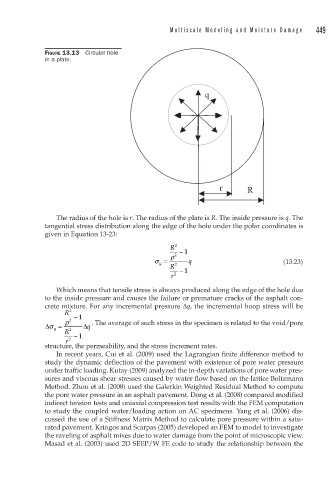Page 457 - Mechanics of Asphalt Microstructure and Micromechanics
P. 457
Multiscale Modeling and Moisture Damage 449
FIGURE 13.13 Circular hole
in a plate.
q
r R
The radius of the hole is r. The radius of the plate is R. The inside pressure is q. The
tangential stress distribution along the edge of the hole under the polar coordinates is
given in Equation 13-23:
R 2
ρ 2 − 1
σ = q (13.23)
θ
R 2
− 1
2
r
Which means that tensile stress is always produced along the edge of the hole due
to the inside pressure and causes the failure or premature cracks of the asphalt con-
crete mixture. For any incremental pressure Δq, the incremental hoop stress will be
R 2
ρ 2 − 1
Δσ = Δq . The average of such stress in the specimen is related to the void/pore
θ 2
R
− 1
r 2
structure, the permeability, and the stress increment rates.
In recent years, Cui et al. (2009) used the Lagrangian finite difference method to
study the dynamic deflection of the pavement with existence of pore water pressure
under traffic loading. Kutay (2009) analyzed the in-depth variations of pore water pres-
sures and viscous shear stresses caused by water flow based on the lattice Boltzmann
Method. Zhou et al. (2008) used the Galerkin Weighted Residual Method to compute
the pore water pressure in an asphalt pavement. Dong et al. (2008) compared modified
indirect tension tests and uniaxial compression test results with the FEM computation
to study the coupled water/loading action on AC specimens. Yang et al. (2006) dis-
cussed the use of a Stiffness Matrix Method to calculate pore pressure within a satu-
rated pavement. Kringos and Scarpas (2005) developed an FEM to model to investigate
the raveling of asphalt mixes due to water damage from the point of microscopic view.
Masad et al. (2003) used 2D SEEP/W FE code to study the relationship between the

